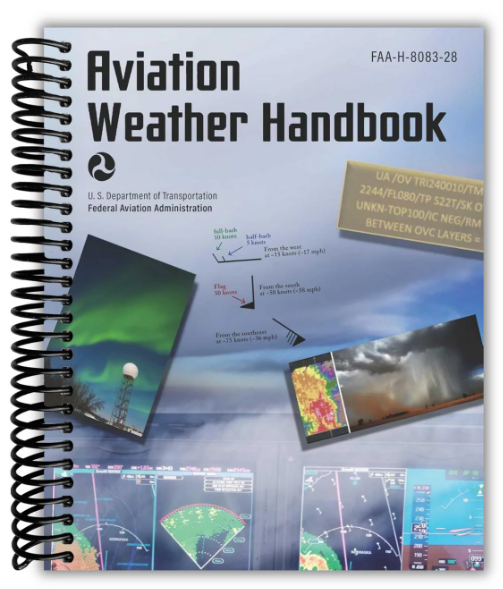Aviation weather is crucial for unmanned aircraft under FAA Part 107. Remote pilots must know how wind, temperature, clouds, visibility, and precipitation impact UAS performance, battery life, and safety. Understanding weather helps interpret forecasts, spot hazards like turbulence, and decide on flight go/no-go. Weather knowledge is required for the FAA exam and vital for safe, compliant operations.

Summary: FAA-H-8083-28A – Aviation Weather Handbook
Overview & Purpose
This handbook consolidates content from six key Advisory Circulars—AC 00-6 (Aviation Weather), AC 00-24 (Thunderstorms), AC 00-30 (Clear Air Turbulence Avoidance), AC 00-45 (Aviation Weather Services), AC 00-54 (Pilot Windshear Guide), and AC 00-57 (Hazardous Mountain Winds)—into a single, comprehensive resource.
Structure & Content Highlights
Chapters 1–3: Introduction, the Aviation Weather Service Program, and an overview of aviation weather information.
Chapters 4–23: Weather fundamentals such as the atmosphere, heat, water vapor, wind, fronts, clouds, precipitation, radar, and specialized domains like mountain, tropical, arctic, thunderstorm, and space weather.
Chapters 24–28: Focus on observations, analysis, advisories, forecasts, and aviation weather tools.
Appendices: Cloud types, conversion charts, density altitude calculations, special terminal procedures, abbreviations, units of measure, and useful aviation websites
FAA-H-8083-28A: Aviation Weather Handbook – Quick Reference
Consolidates six aviation weather Advisory Circulars into one modern technical reference for NAS users. Aligns with FAA weather training and complements CFR and AIM.
- Chapters 1–3: Introduction, Weather Service Program, Info Overview
- Chapters 4–23: Weather theory & environments (atmosphere, wind, clouds, icing, turbulence, etc.)
- Chapters 24–28: Observations, Analysis, Advisories, Forecasts, Tools
- Appendices: Cloud types, conversions, abbreviations, tools, websites
Acts as voluntary guidance—not regulatory. Nonconformity does not affect legal status.
The December 2024 edition (FAA-H-8083-28A) includes updates to weather forecast guidance and clarifies references to the NWS Aviation Weather Center webpage.

AC 00-6: Aviation Weather – Quick Reference
1. Overview
AC 00-6 (“Aviation Weather”) is a historical FAA advisory circular originally issued in 1965 and updated as AC 00-6A in 1975. It served as a foundational guide to weather theory and its aviation application. AC 00-6A was officially cancelled in August 2016 and succeeded by AC 00-6B.
2. Purpose & Structure
- Training resource: Offers essential weather knowledge for pilots and dispatch personnel.
- Not regulatory: Intended as guidance—not enforceable rules.
- Part I: Covers core atmospheric concepts—composition, pressure, temperature, wind.
- Part II: Focuses on weather in specific environments—high altitude, tropical, Arctic, soaring.
3. Modern Updates
The AC is being phased out, with its information now consolidated into the FAA Aviation Weather Handbook (FAA-H-8083-28). This handbook combines several weather-related ACs into one technical reference for flight planning, training, and decision-making.
4. Key Takeaways
- Use AC 00-6 as a historical reference or training foundation—but rely on the Aviation Weather Handbook for current practices.
- The guidance is voluntary and non-binding on regulations.
- Focus remains on understanding weather phenomena and making informed decisions—recognizing good vs. marginal vs. hazardous conditions.